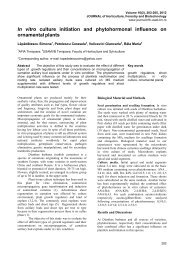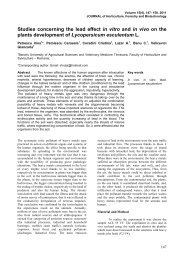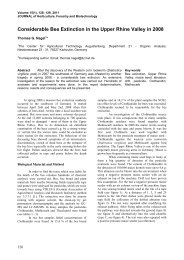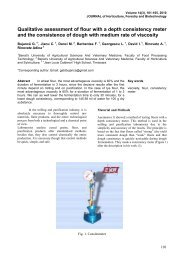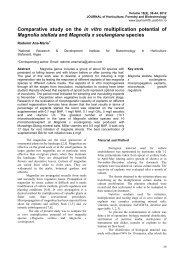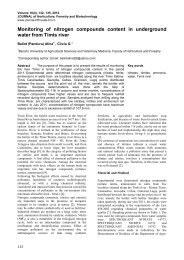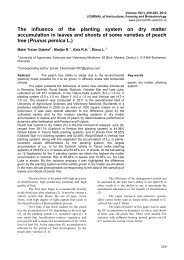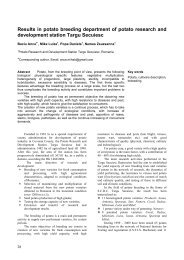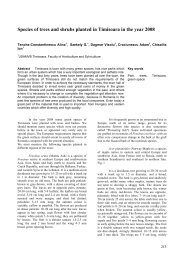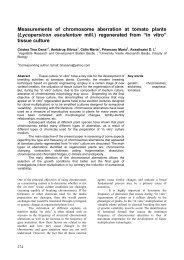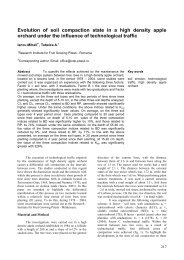Endophytic fungi from Vitis vinifera L. isolated in Canary Islands and ...
Endophytic fungi from Vitis vinifera L. isolated in Canary Islands and ...
Endophytic fungi from Vitis vinifera L. isolated in Canary Islands and ...
You also want an ePaper? Increase the reach of your titles
YUMPU automatically turns print PDFs into web optimized ePapers that Google loves.
ice to avoid any shortcom<strong>in</strong>gs related to improper h<strong>and</strong>l<strong>in</strong>g. Both tubes <strong>and</strong>micropipette tips to have been sterilized by autoclav<strong>in</strong>g.Only five of the 10 RAPD primers tested generated b<strong>and</strong>s toregenerate ALBITZIA LEBECK genotype OPA-09, OPA-13, OPA-17, OPC-11, OPC-14. For Albizzia julibris<strong>in</strong> was tested 10 RAPD primers <strong>and</strong> only 5has generated b<strong>and</strong>s.Production of virus free potato plantletsDanci M., 1* Danci Oana 1 , Mike Luiza 2 , Baciu Anca 2 , Olaru Daniela 1 , Petolescu Cerasela 1 ,Berbentea F. 1 , David I. 11 Banat‟s University of Agricultural Sciences <strong>and</strong> Veter<strong>in</strong>ary Medic<strong>in</strong>e Timişoara; 2 Potato Research <strong>and</strong>Development Station – Targu Secuiesc, Romania*Correspond<strong>in</strong>g author. Email: marcel_research@yahoo.comAbstract Potatoes a high susceptibility to viral, bacterial <strong>and</strong> fungaldiseases impose production of virus free material for healthy seed productions<strong>in</strong>ce plant viruses are pathogens that cannot be destroyed by us<strong>in</strong>g plantprotection chemicals. Meristem tip culture technique is one of the most usedfor potato <strong>in</strong> vitro culture <strong>in</strong>itiation <strong>and</strong> is most of all used <strong>in</strong> order to obta<strong>in</strong>virus free plantlets. For this study six new Romanian potato cultivars wereused. Explants were prepared for tissue culture <strong>and</strong> half of them underwentchemical (us<strong>in</strong>g the antiviral chemical-ribavir<strong>in</strong>) treatement. Culture tubeswere <strong>in</strong>cubated at 20-21 o C <strong>in</strong> 16 hr photoperiod with 2000 lux light <strong>in</strong>tensityfor 6-8 weeks. Leaf samples of 10 plantlets of each cultivar were tested forviruses: PVS, PVY, PVX <strong>and</strong> PLRV by ELISA technique. Virus-free<strong>in</strong>dividuals were measured for several biometrical parameters <strong>and</strong>subcultured on fresh multiplication media for 4 weeks. Best virus freeproduction was obta<strong>in</strong>ed after Ribavir<strong>in</strong> treatment even if regenerationcapacity after chemical therapy decreased with around 10%.Key wordsmeristem tip culture, virusfreeplantlets regeneration,virus <strong>in</strong>dex<strong>in</strong>g, Solanumtuberosum L., Ribavir<strong>in</strong>Evaluation of some <strong>in</strong>direct <strong>in</strong>dices to identify droughttolerance <strong>in</strong> barleyVelicevici Giancarla 1 *, Madosă E. 1 , Şumălan R. 1 , Ciulca Adriana 1 , Petolescu Cerasela 11 University of Agricultural Sciences <strong>and</strong> Veter<strong>in</strong>ary Medic<strong>in</strong>e of Banat Timisoara, Faculty of Horticulture <strong>and</strong>Forestry, Calea Aradului 119, 300645, Romania*Correspond<strong>in</strong>g author. Email: giancarlavely2000@yahoo.comAbstract The obiective of this study was to evaluate the ability of several<strong>in</strong>dices to identify drought tolerance of some hybrids <strong>in</strong> laboratory conditions.Germ<strong>in</strong>ation stress <strong>in</strong>dex (GSI), Promptness <strong>in</strong>dex <strong>in</strong> stress (PIS) <strong>and</strong> nonstress (PINS) conditions were recordered <strong>in</strong> the controlled conditions oflaboratory under two different stress <strong>and</strong> non stress water regime. Theosmotic stress were <strong>in</strong>duced by PEG 6000 solution with the osmotic potential( 0 Bars, -7.35 Bars) us<strong>in</strong>g method suggested by Kaufman, <strong>and</strong> replicatedthree time, at a temperature of 22±2 o C. Therefore, drought <strong>in</strong>duced by us<strong>in</strong>gphysiological germ<strong>in</strong>ation solutions with a different osmotic pressure levelsdirectly <strong>in</strong>fluence the germ<strong>in</strong>ation of the seed<strong>in</strong>g material. These <strong>in</strong>dices maybe screened for <strong>in</strong>direct selection of drought tolerance <strong>in</strong> the <strong>in</strong>itial stage ofthe crop growth.Key wordsStress tolerance <strong>in</strong>dex,germ<strong>in</strong>ation stress <strong>in</strong>dex,barley



